ARROZ PRIMAVERA VENEZOLANO
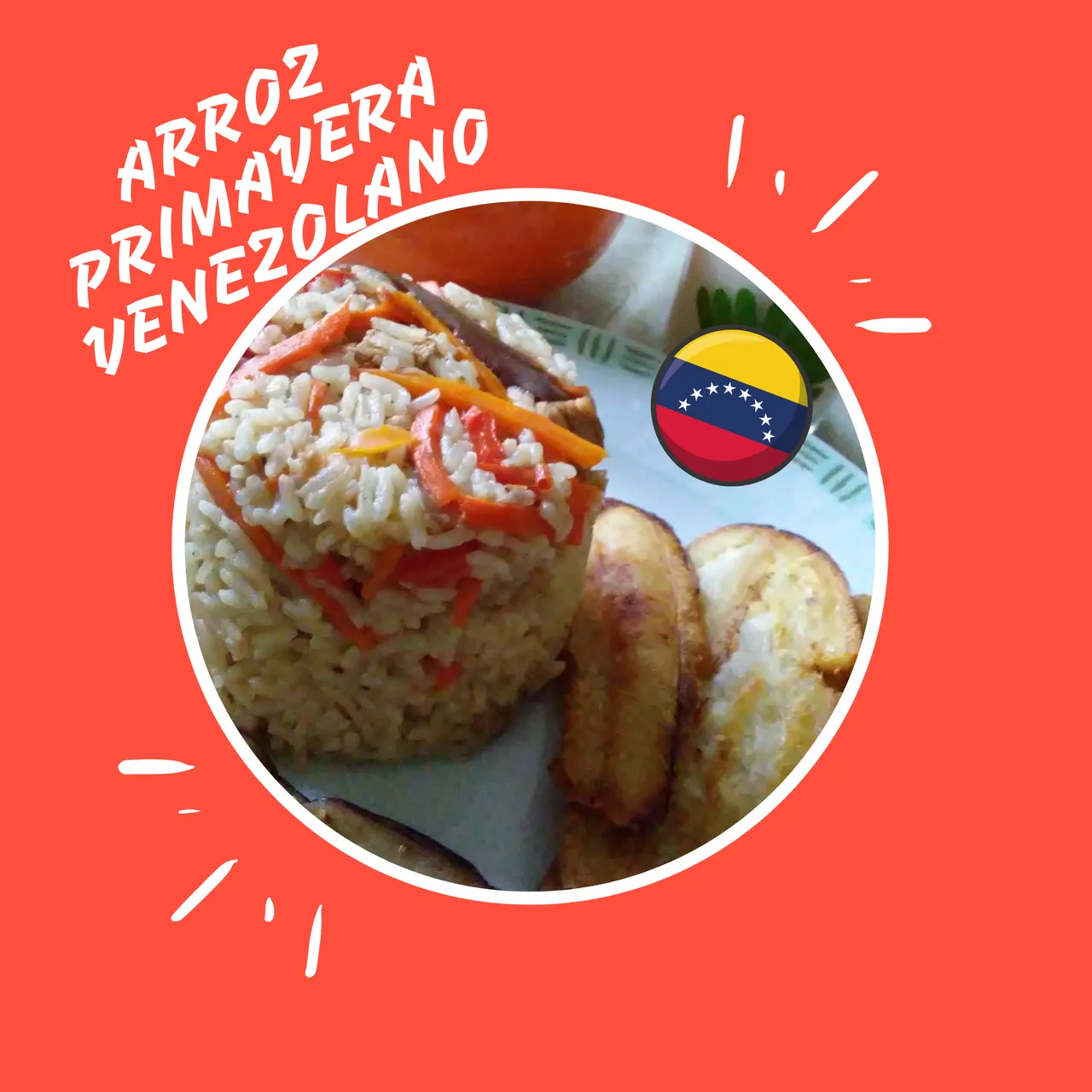
Hello dear readers of this community. Today I want to share a very simple cooking recipe that we make at home this weekend.
Realmente queríamos preparar algo rico de comer, pero como nuestro presupuesto era bastante limitado, decidimos revisar en la nevera y en la despensa a ver qué conseguíamos.
We really wanted to prepare something delicious to eat, but since our budget was quite limited, we decided to check in the fridge and pantry to see what we could get.
Ingredientes que encontramos:
Ingredients we find:
Ingredients we find:

Cómo fuimos procesando los diferentes ingredientes:
How we were processing the different ingredients:
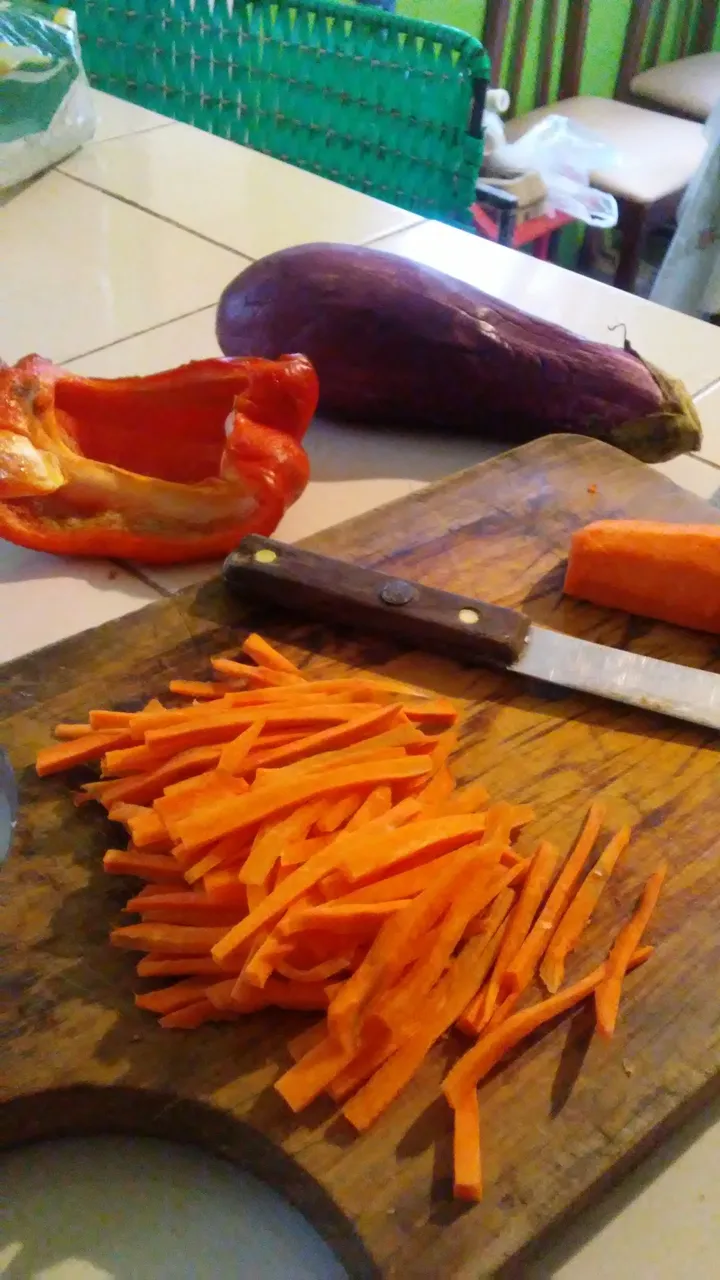 Primero que nada, lavamos muy bien todos los vegetales que utilizaríamos. Seguidamente se le retiró la piel.
Primero que nada, lavamos muy bien todos los vegetales que utilizaríamos. Seguidamente se le retiró la piel.
First of all, we wash all the vegetables that we would use very well. The skin was then removed.
También lavamos una pechuga de pollo y le quitamos la piel.
We also wash a chicken breast and remove the skin.
Picamos la zanahorias a la mitad para hacer los cortes al estilo "juliana", es decir, en palitos delgados. Tal como te los muestro en la foto a la derecha.
Chop the carrots in half to make the "julienne" cuts, that is, into thin sticks. As I show you in the photo on the right.

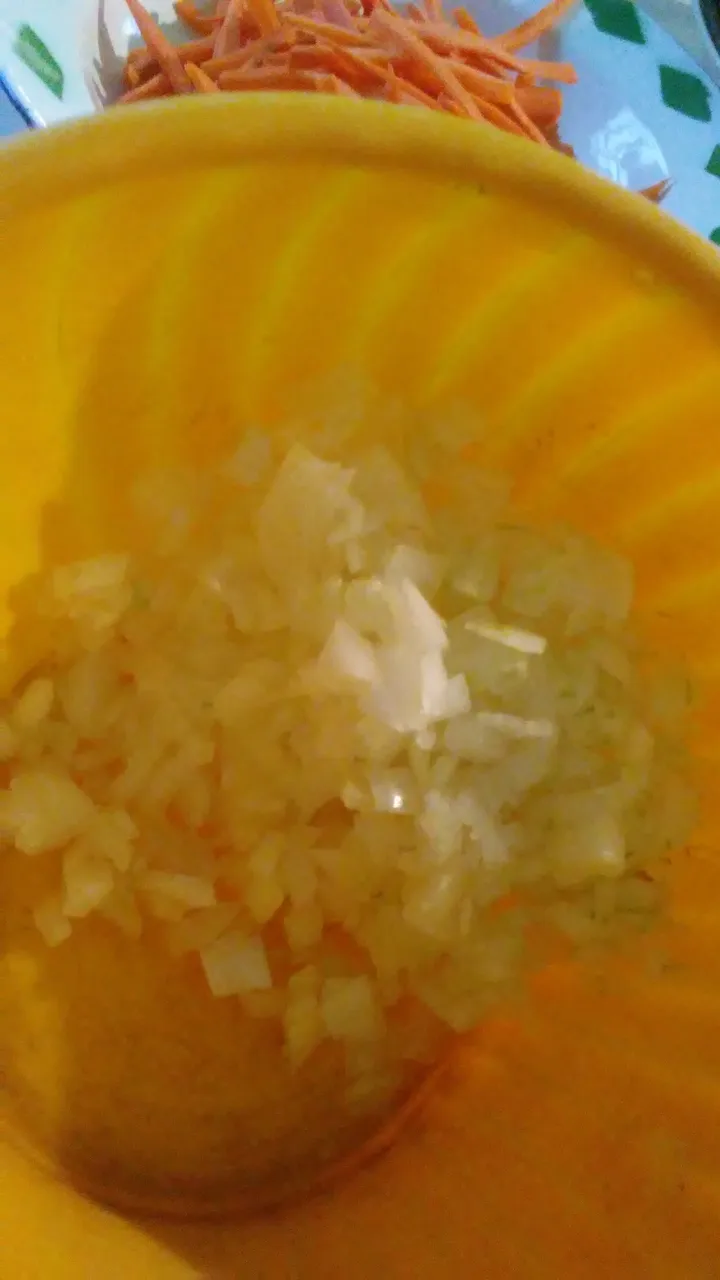 Así mismo hicimos con el pimentón. Pero la cebolla la cortamos en cuadritos pequeños al igual que el ajo. Estos dos últimos los colocamos en el mismo recipiente, mientras que los otros ingredientes los mantuvimos separados.
Así mismo hicimos con el pimentón. Pero la cebolla la cortamos en cuadritos pequeños al igual que el ajo. Estos dos últimos los colocamos en el mismo recipiente, mientras que los otros ingredientes los mantuvimos separados.
We also did with the paprika. But we cut the onion into small squares just like the garlic. We put these last two in the same container, while the other ingredients were kept separate.
(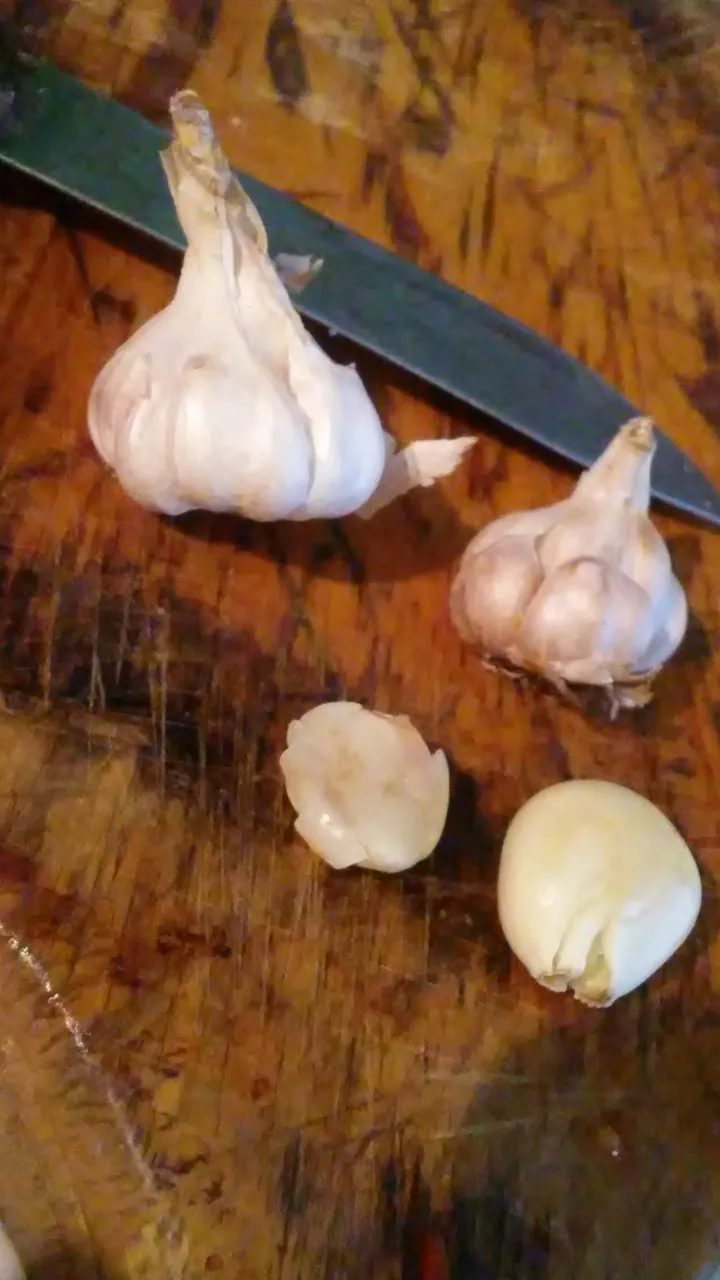
Un dato interesante:
para que se te haga mucho más fácil retirar la piel del ajo, primero presiónalo contra una superficie dura.
En nuestro caso, la tabla para picar de madera.
Entonces la piel se rompe y es más fácil sacar el ajo ya pelado para picarlo en cuadritos pequeños.
--
An interesting fact:
To make it much easier for you to remove the skin from the garlic, first press it against a hard surface.
In our case, the wooden chopping board.
Then the skin breaks and it is easier to remove the peeled garlic to chop it into small squares.
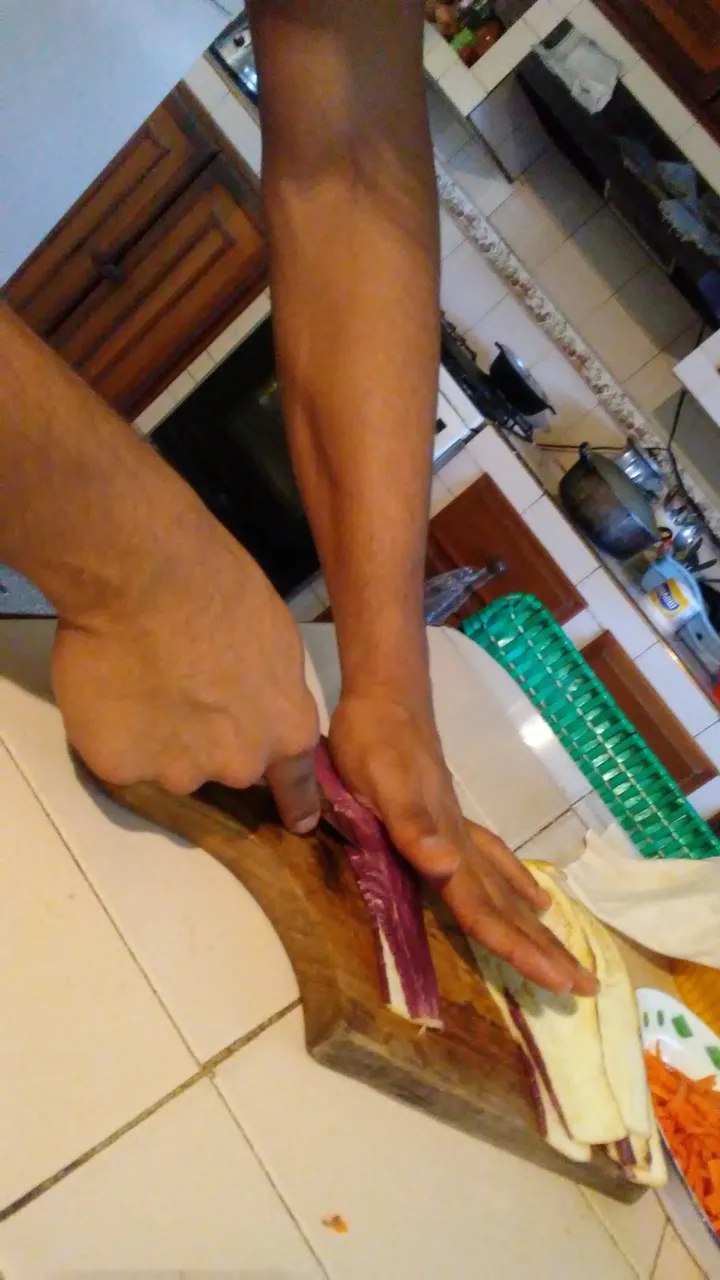
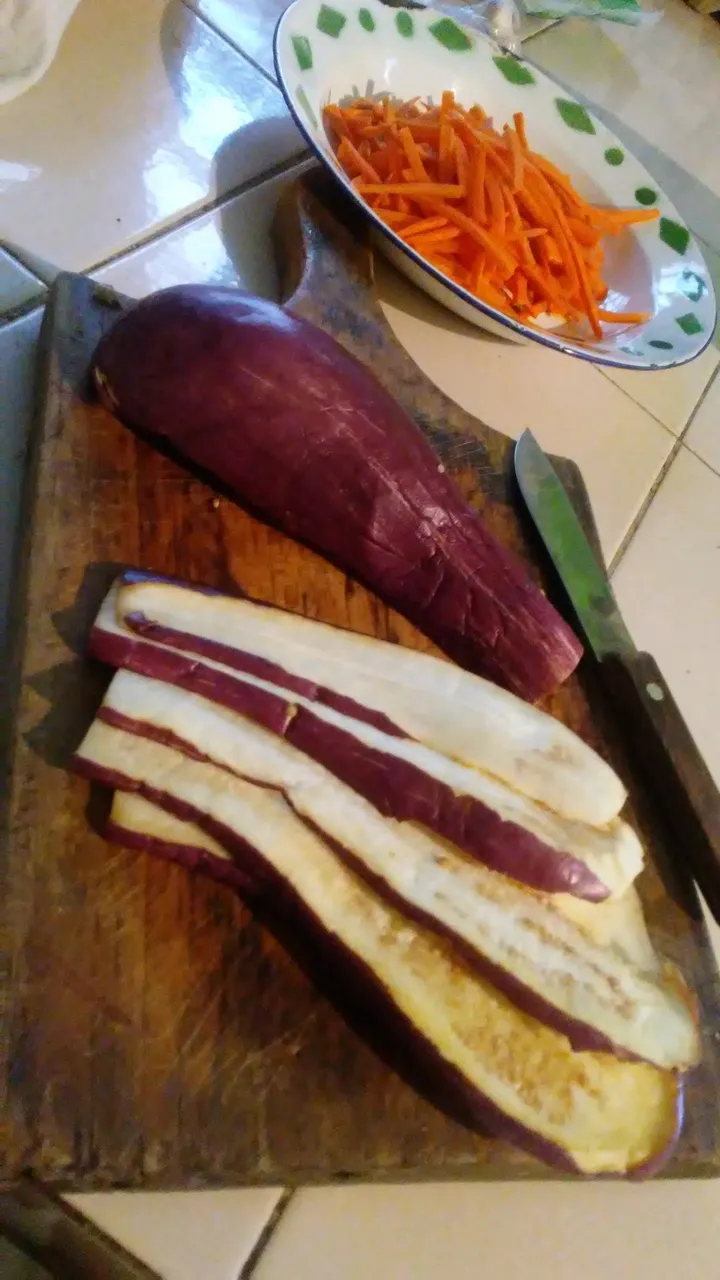 La berenjena, a diferencia de los otros vegetales, no le retiramos la piel, sino que con ella misma la cortamos en rebanadas horizontales, sacando una especie de lajas o tajadas.
La berenjena, a diferencia de los otros vegetales, no le retiramos la piel, sino que con ella misma la cortamos en rebanadas horizontales, sacando una especie de lajas o tajadas.
Eggplant, unlike other vegetables, we do not remove the skin, but with it we cut it into horizontal slices, removing a kind of slabs or slices.
De esas tajadas cortamos dos a la juliana, para añadirlas al arroz, mientras que las demás las reservamos para hacerlas a la plancha como contorno.
From these slices we cut two julienne strips, to add them to the rice, while the rest we reserve to grill them as an outline.
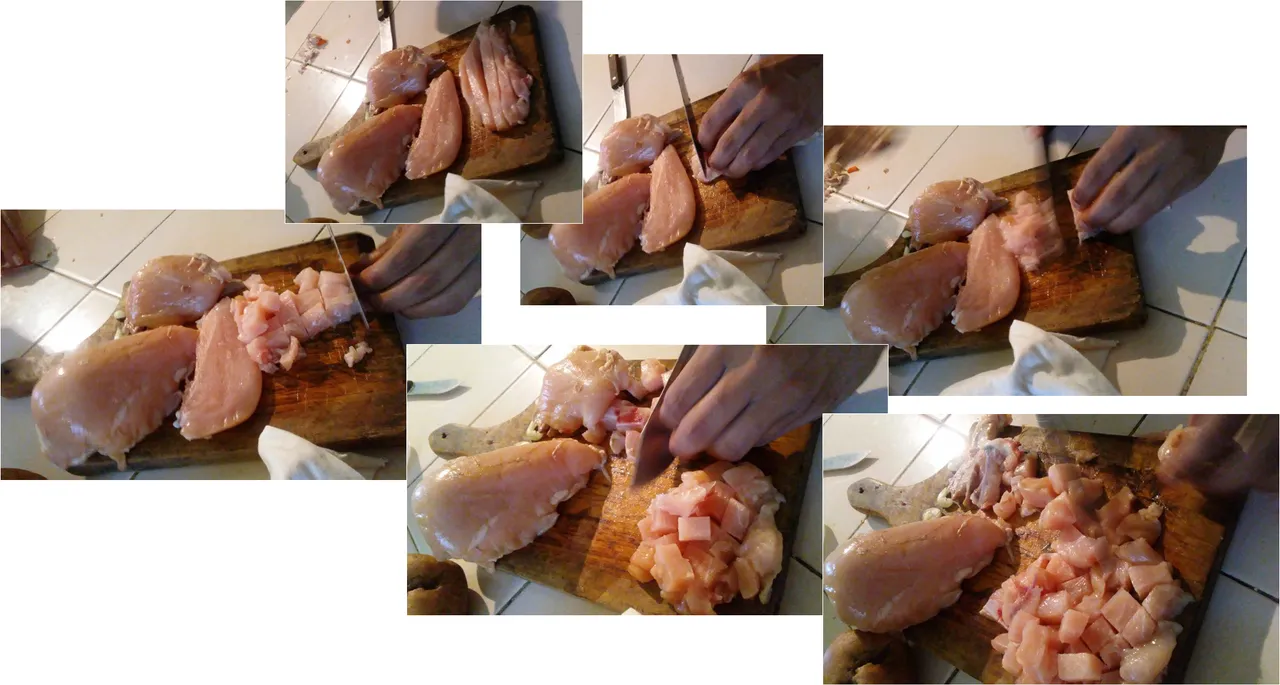
Finally it was the chicken's turn. Chop the raw breast into sticks and then into squares. Of a prudential size, so that it would yield in quantity and at the same time the sensation of chewing the chicken with the rice at the end of cooking everything was felt.
Tiempo de Cocinar
Cooking time
Luego de tener todos los ingredientes listos pasamos a la cocina. Tomamos un caldero de hierro con tapa y le agregamos aceite vegetal comestible. Lo colocamos a calentar a fuego medio. Cuando vimos que ya estaba hirviendo agregamos el pollo picado y revolvimos sin parar hasta que estuvo doradito.
After having all the ingredients ready we go to the kitchen. We take an iron cauldron with a lid and add edible vegetable oil. We place it to heat over medium heat. When we saw that it was already boiling we added the minced chicken and we stirred without stopping until it was golden brown.
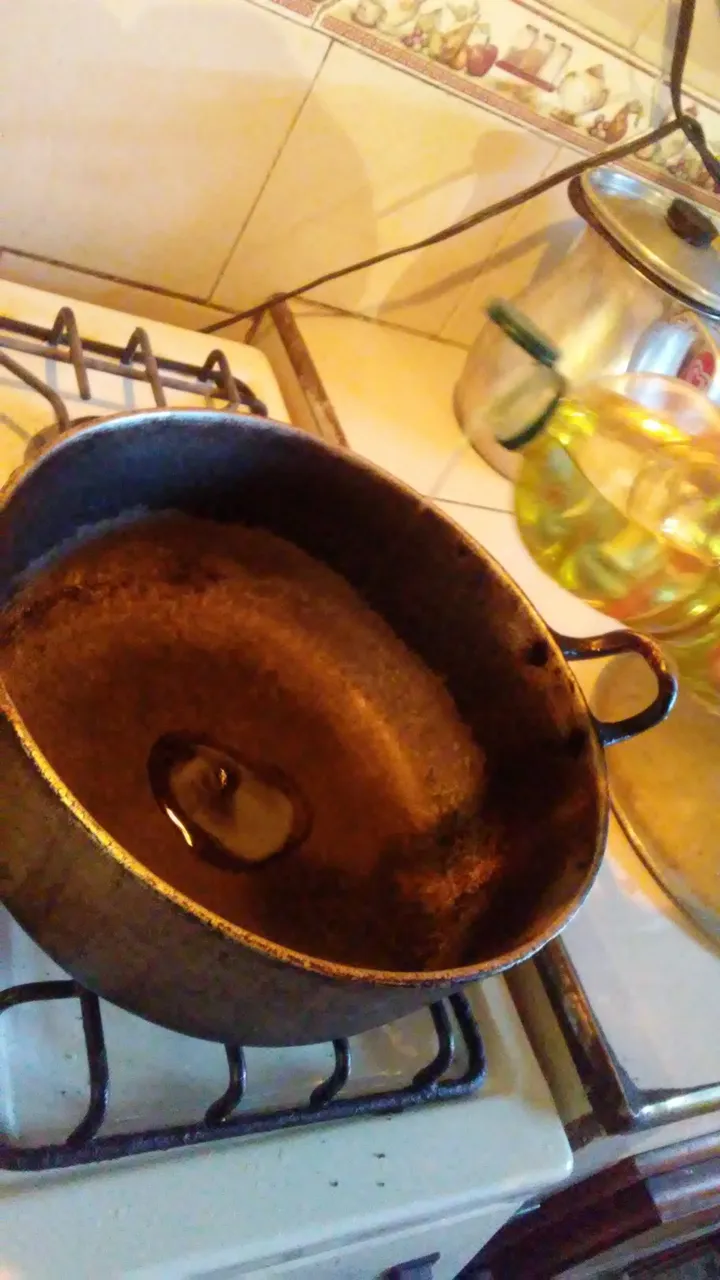
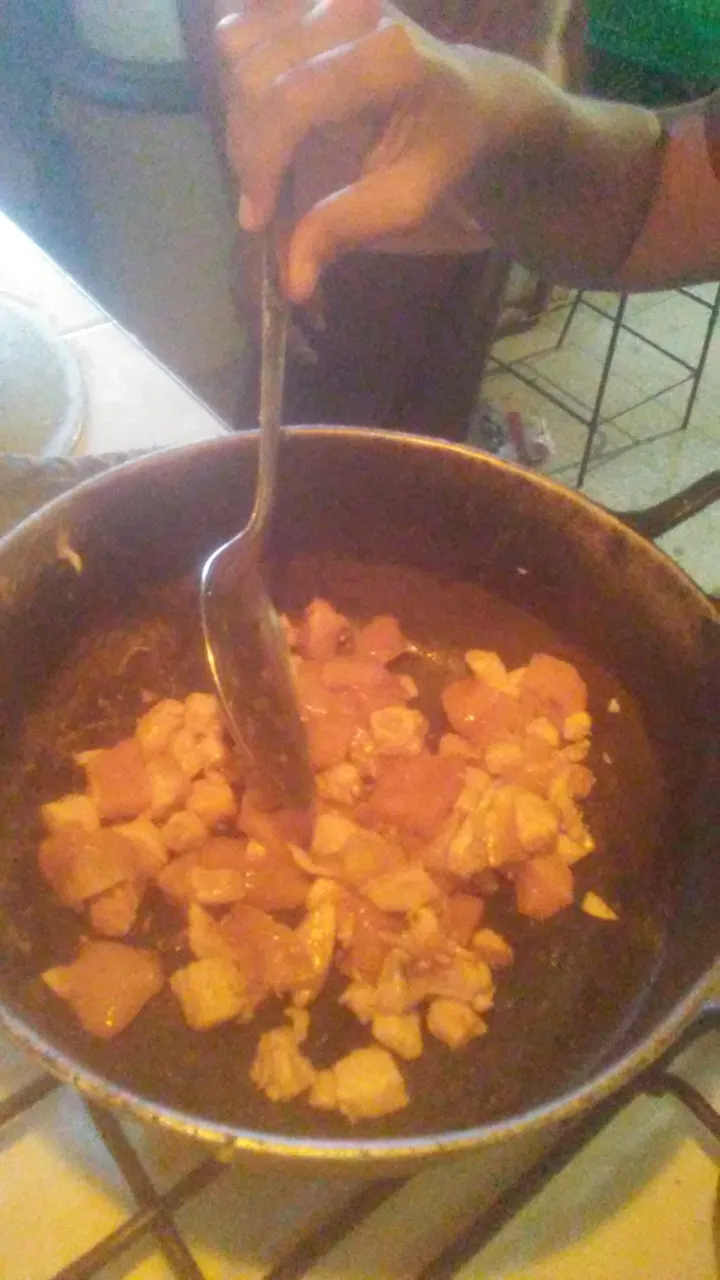

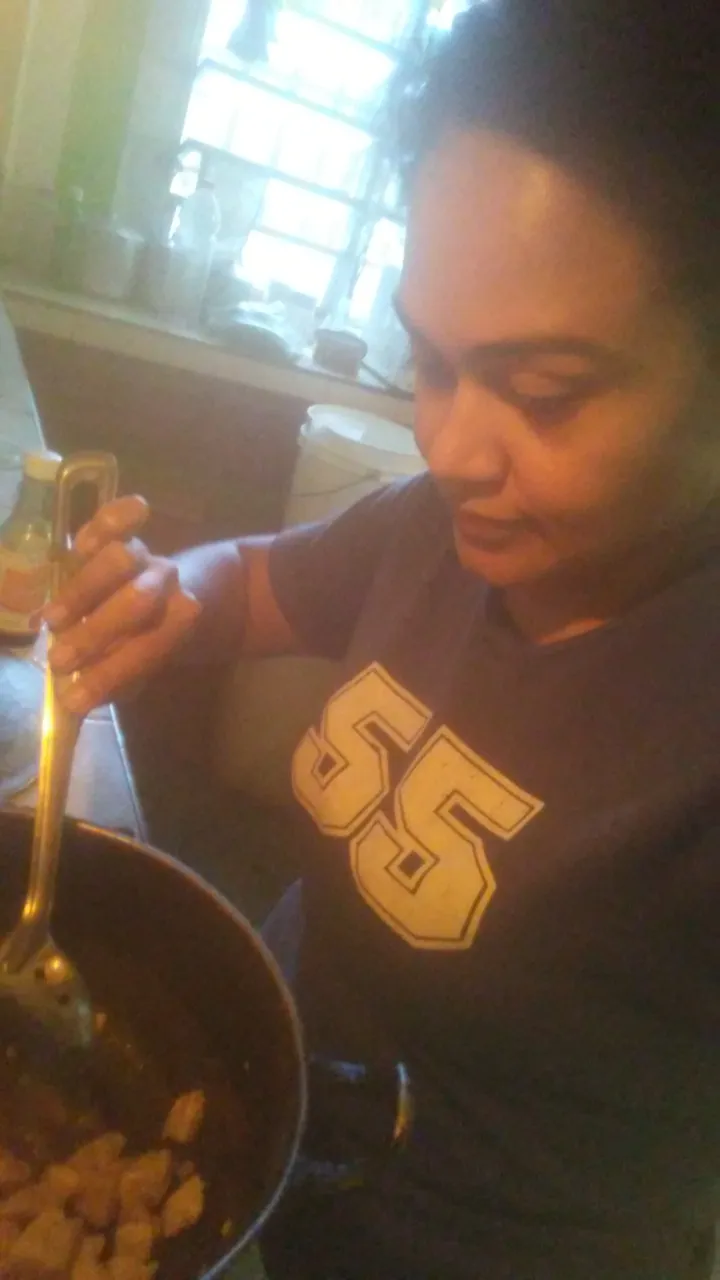 Le agregamos, la sal, el orégano, la salsa de soya y la salsa inglesa al gusto. Y seguimos removiendo constantemente para que no se nos pegara o quemara. Cuando ya notamos que el pollo suelta como una aguita propia, lo escurrimos con una paleta con agujeros que aquí llamamos espumadera. Lo colocamos en un plato aparte. En ese mismo caldero, con ese mismo aceite y sazón que soltó el pollo, seguiremos con el resto de la preparación.
Le agregamos, la sal, el orégano, la salsa de soya y la salsa inglesa al gusto. Y seguimos removiendo constantemente para que no se nos pegara o quemara. Cuando ya notamos que el pollo suelta como una aguita propia, lo escurrimos con una paleta con agujeros que aquí llamamos espumadera. Lo colocamos en un plato aparte. En ese mismo caldero, con ese mismo aceite y sazón que soltó el pollo, seguiremos con el resto de la preparación.
We add salt, oregano, soy sauce and Worcestershire sauce to taste. And we keep stirring constantly so that it does not stick or burn us. When we already notice that the chicken is loose as its own water, we drain it with a palette with holes that we call the slotted spoon here. We put it on a separate plate. In that same cauldron, with the same oil and seasoning that the chicken released, we will continue with the rest of the preparation.
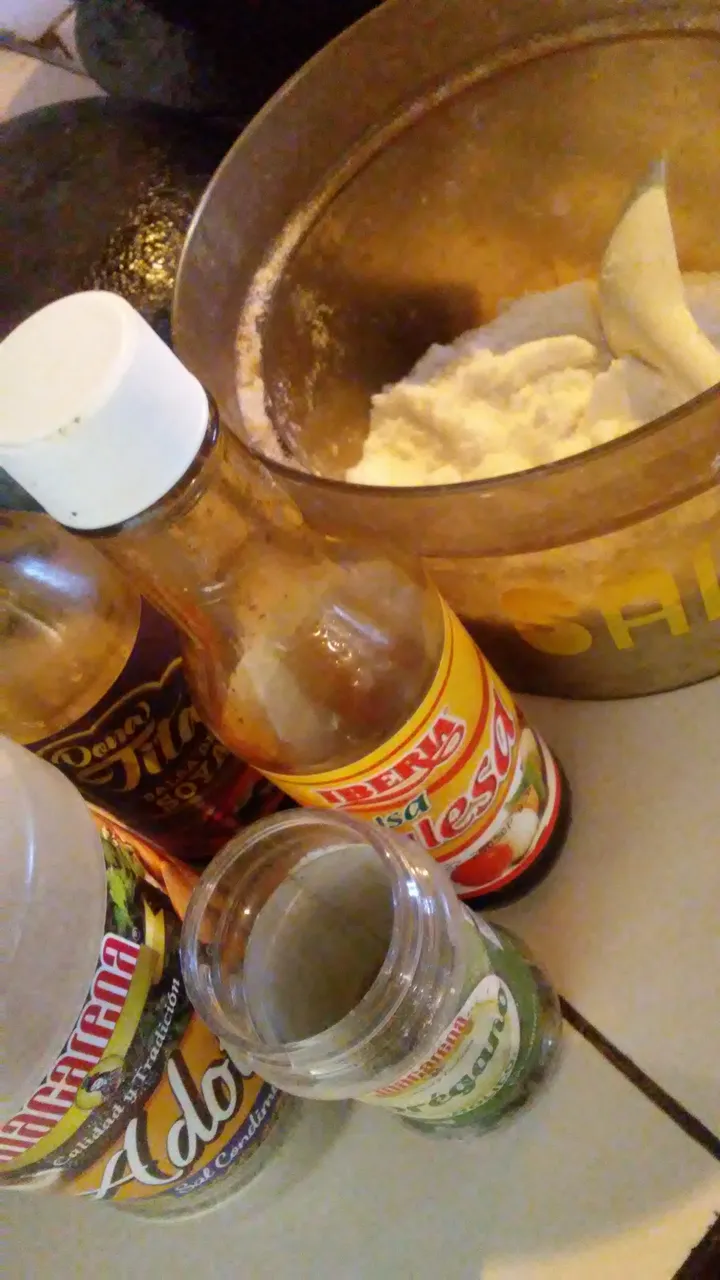
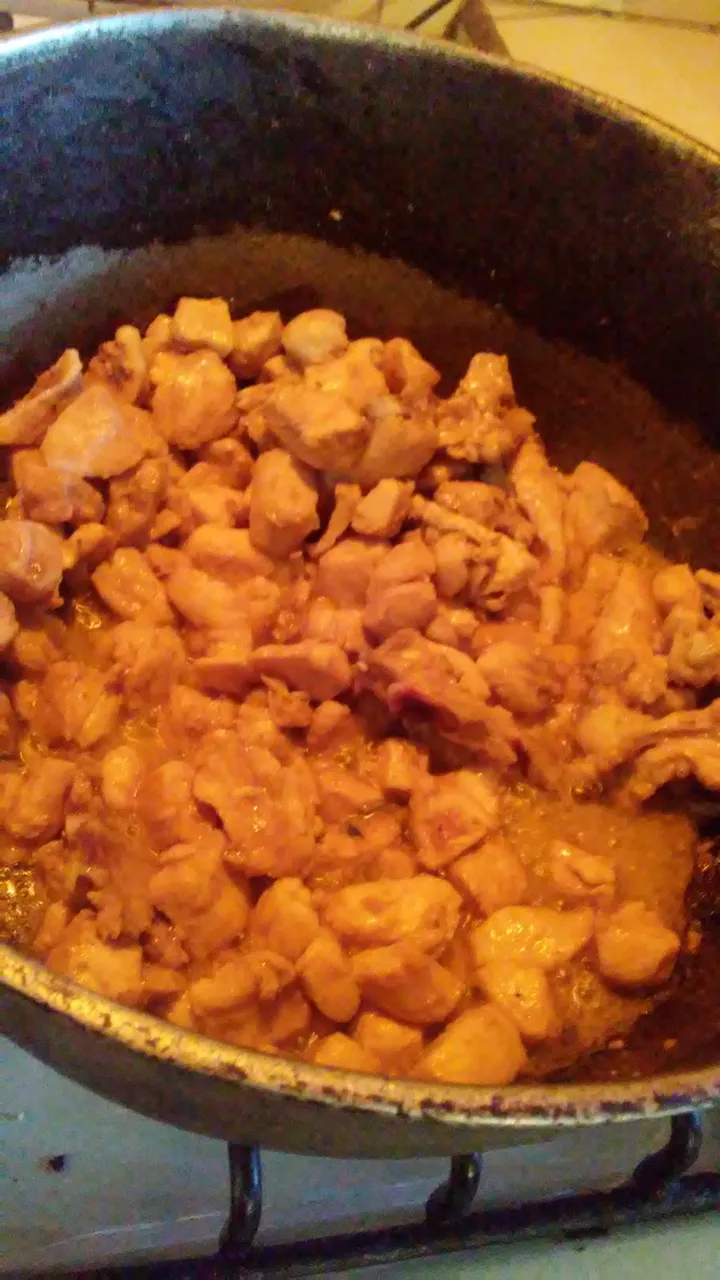 Salteamos los vegetales (Saltear es como sofreír pero no completamente). Primero las zanahorias(1). Cuando estuvieron doraditas, agregamos el pimentón rojo (2). Luego la cebolla en cuadritos (3). Al ver que la cebolla esta transparentándose, sabemos que ya es el momento de agregar más ingredientes (4). Siempre removiendo, para que no se pegue, a fuego medio (5). Es tiempo entonces de sumar la parte de berenjena a la juliana que habíamos apartado (6). Hasta que todo nos quede como cristalizado (7).
Salteamos los vegetales (Saltear es como sofreír pero no completamente). Primero las zanahorias(1). Cuando estuvieron doraditas, agregamos el pimentón rojo (2). Luego la cebolla en cuadritos (3). Al ver que la cebolla esta transparentándose, sabemos que ya es el momento de agregar más ingredientes (4). Siempre removiendo, para que no se pegue, a fuego medio (5). Es tiempo entonces de sumar la parte de berenjena a la juliana que habíamos apartado (6). Hasta que todo nos quede como cristalizado (7).
Sauté the vegetables (Sautéing is like frying but not completely). Carrots first (1). When they were golden brown, we added the red paprika (2). Then the diced onion (3). Seeing that the onion is transparent, we know that it is time to add more ingredients (4). Always stirring, so that it does not stick, over medium heat (5). It is time then to add the part of aubergine to the julienne that we had set aside (6). Until everything is as crystallized (7).
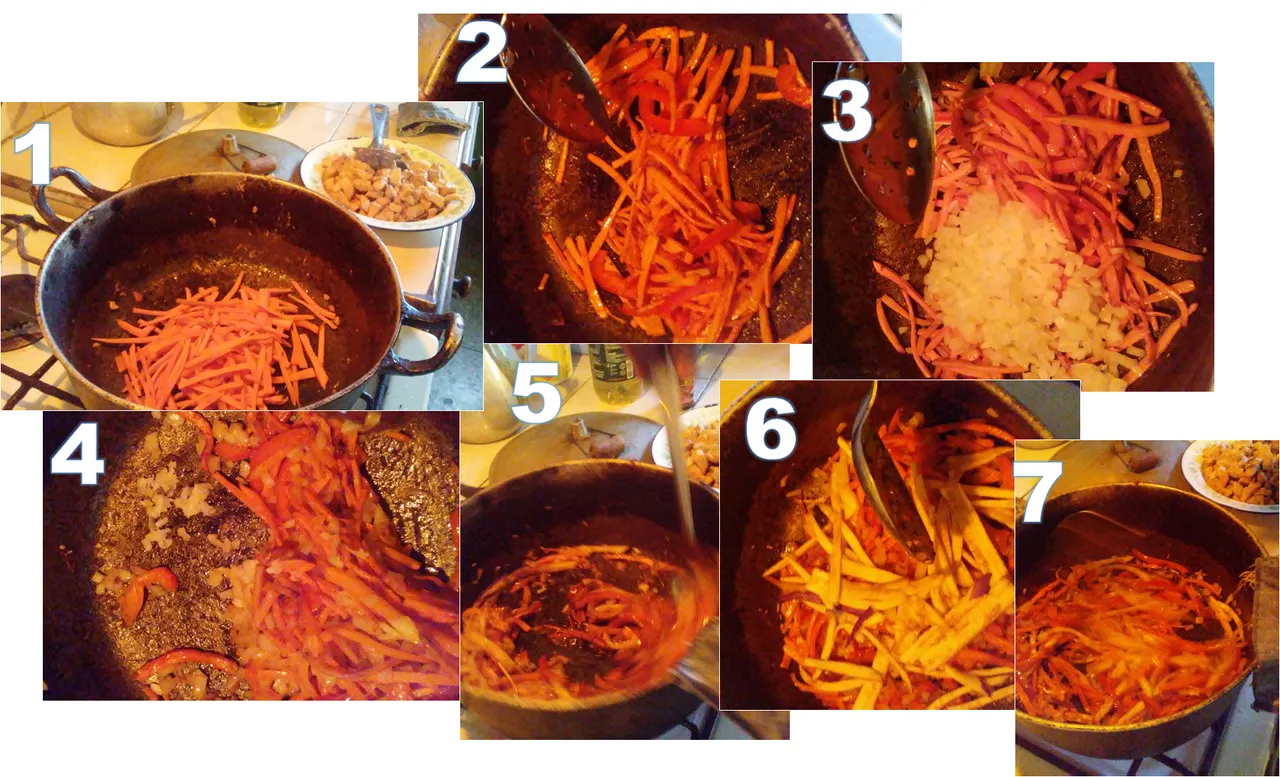
Add the previously chosen but unwashed rice (1), and keep frying until it is crystallized (2), or looks whiter. Just then we add the chicken (3) and continue stirring. When everything is well joined we add water, in double proportion in relation to the rice, that is, if it is two cups of rice, it will be four of water (4). We test if it is well of salt, add a little more to taste and cover, always over medium heat. It only remains to wait until the rice grain is softened and the water dries.

Mientras el arroz se terminaba, hice los contornos: coloqué la berenjena a la plancha y freí los plátanos verdes topochos para hacer tostones.
While the rice was finishing, I made the contours: I placed the grilled aubergine and fried the green plantains topochos to make tostones.
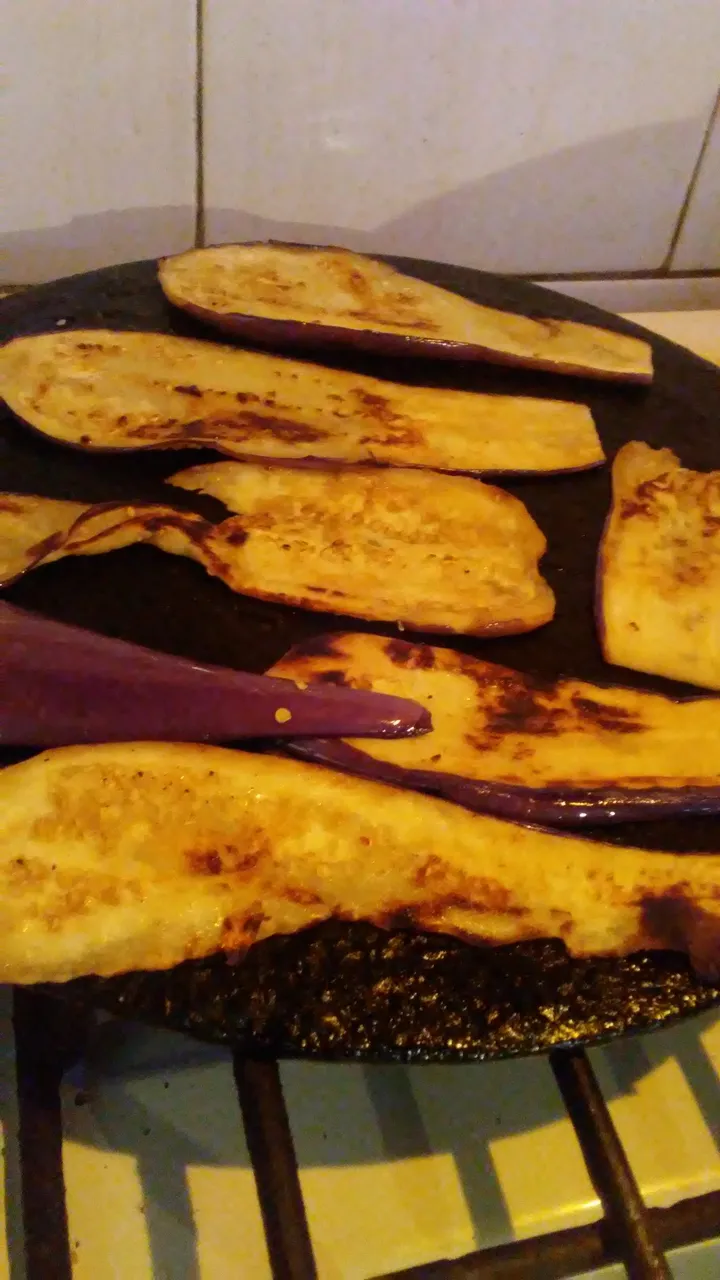
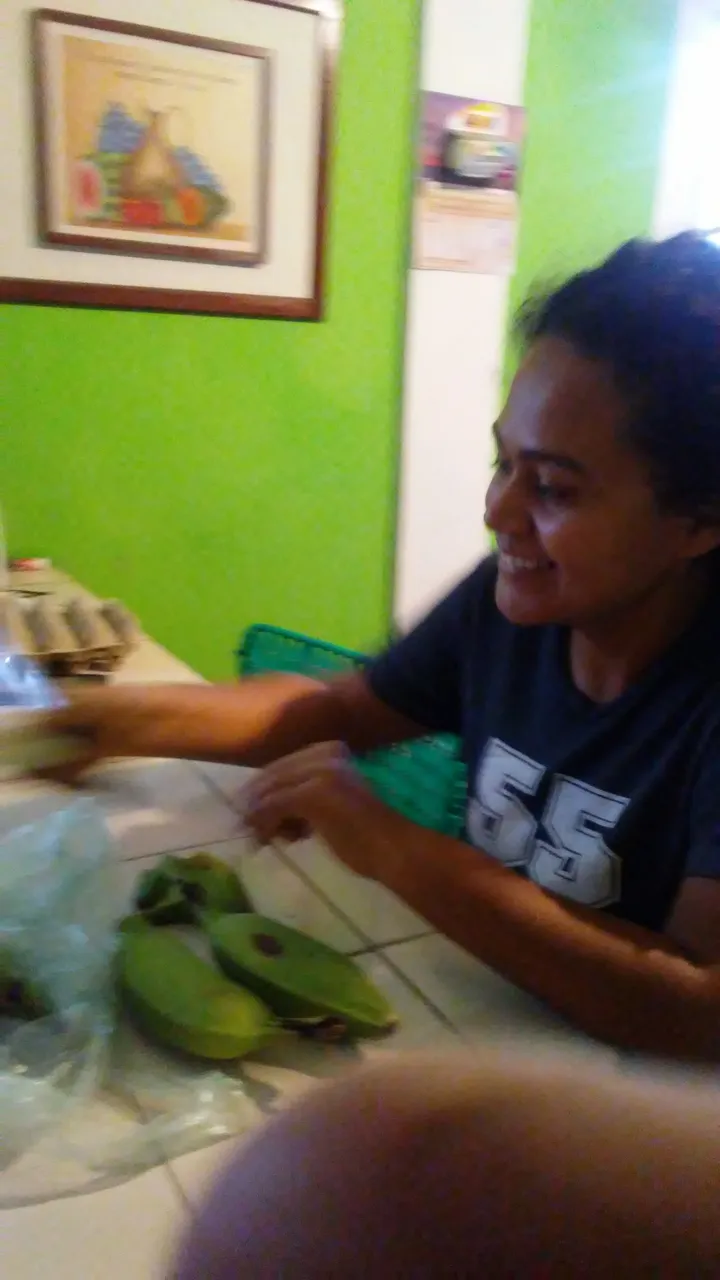
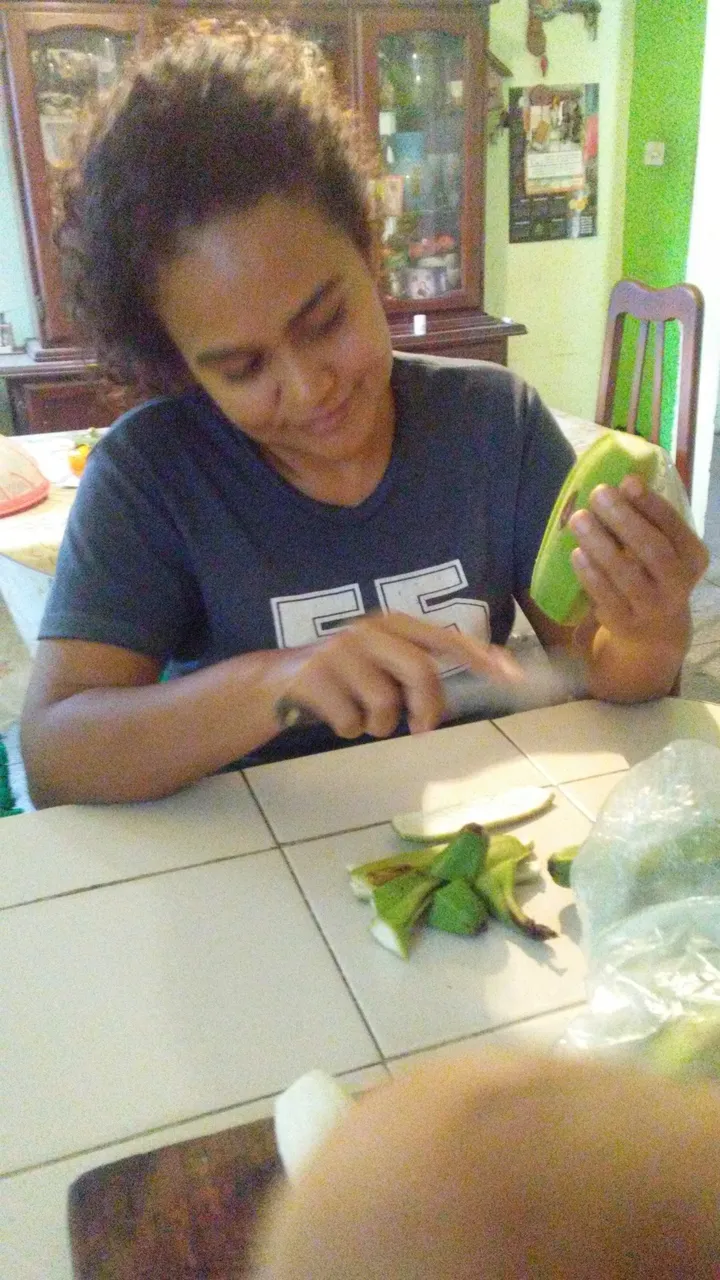
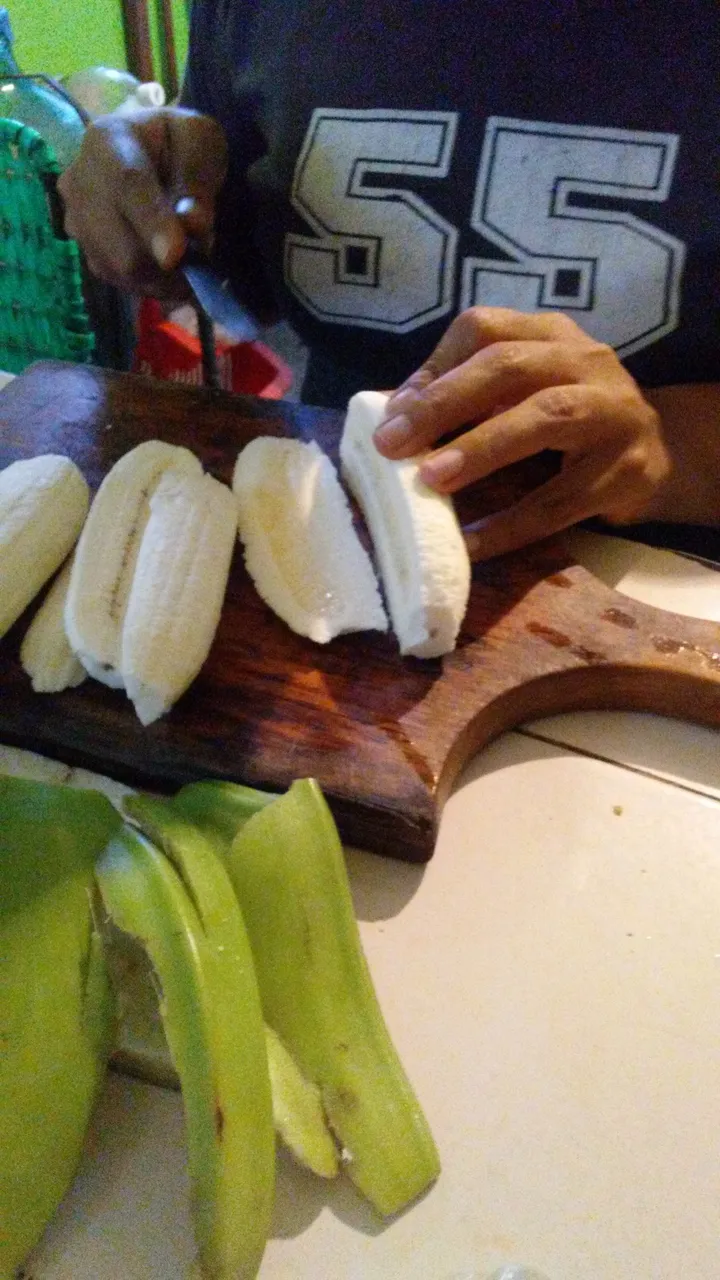
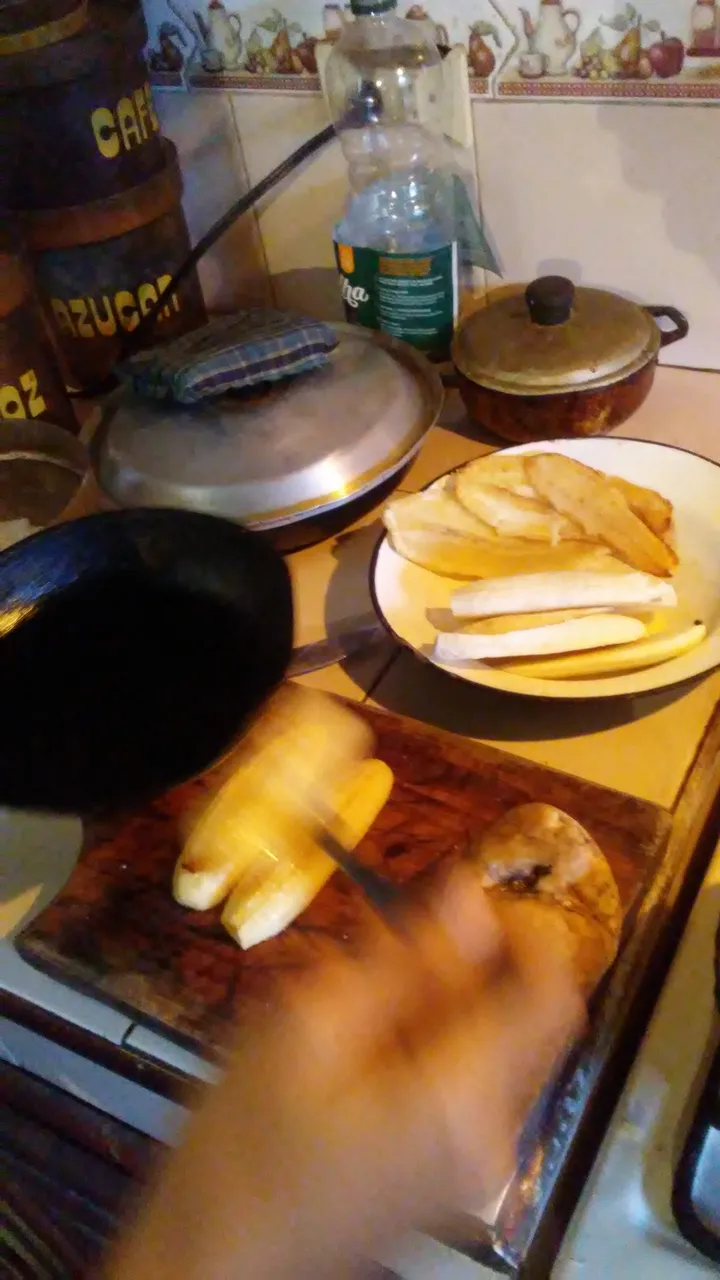
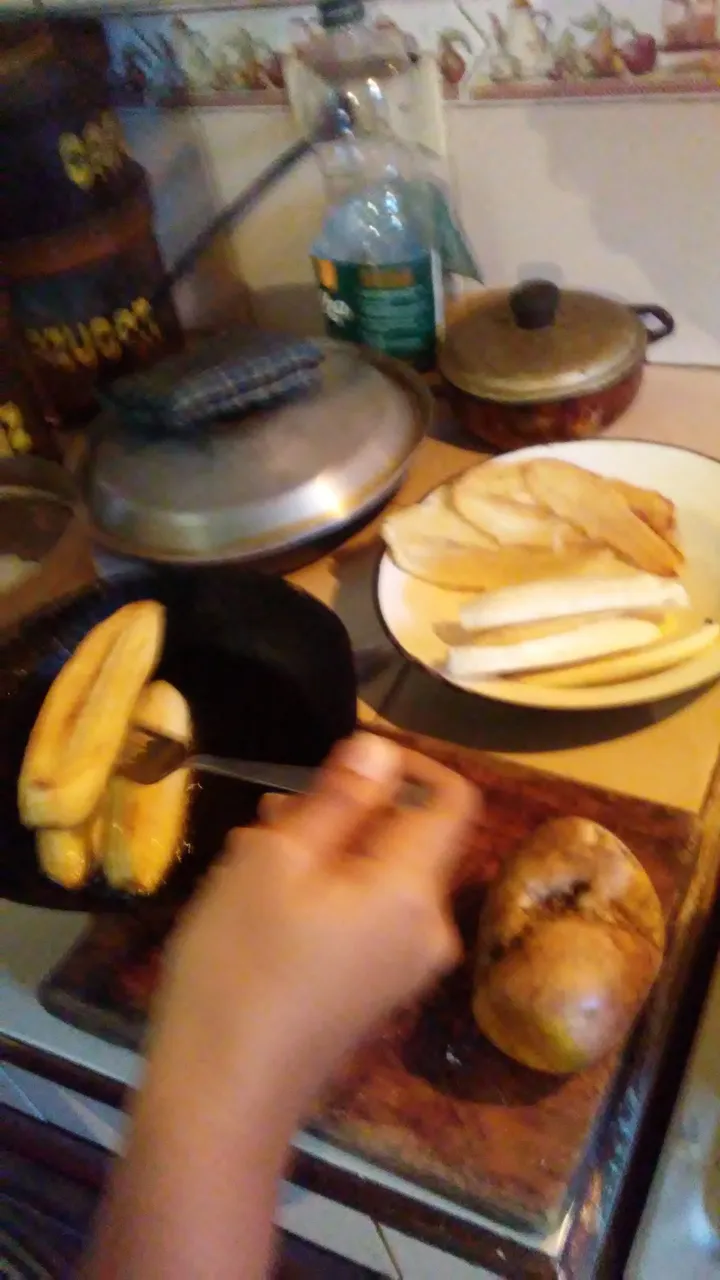
Cuando todo estuvo listo, retiramos del fuego y procedimos a servir. Este fue el resultado final:
When everything was ready, we removed from the fire and proceeded to serve. This was the final result:
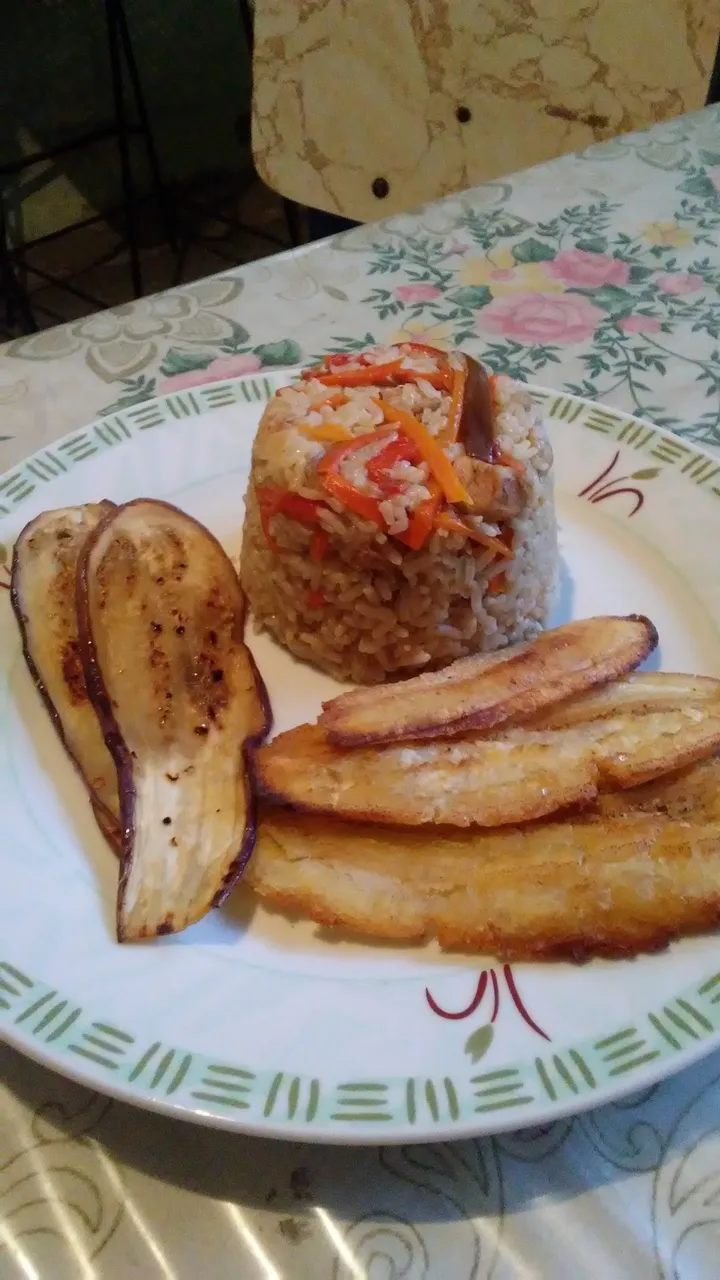
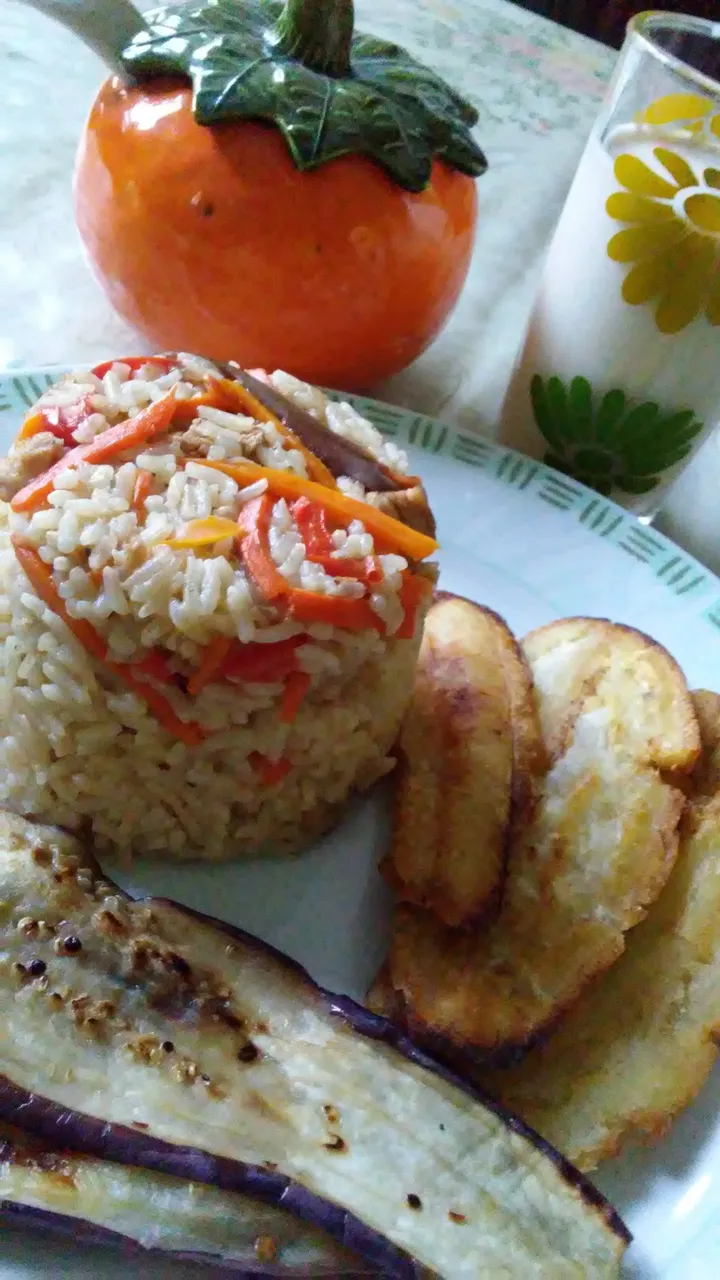
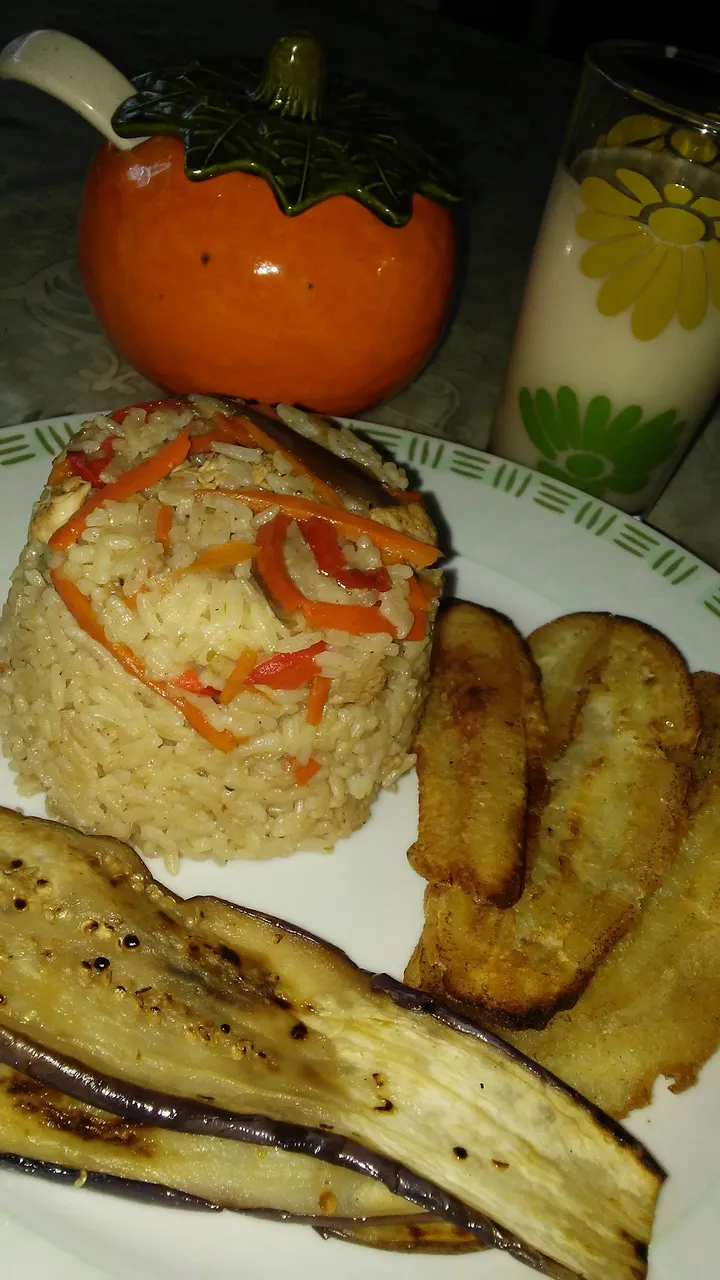
A todos nos gustó la comida, pero olvidé tomar las fotos de todos nosotros agradados y satisfechos.
Comimos 4 adultos y nos quedó 4 porciones para el día siguiente.
We all liked the food, but forgot to take photos of all of us pleased and satisfied.
We ate 4 adults and had 4 servings left for the next day.
Aquí les dejo un vídeo que hice con las fotos que tomé ese día:
Nos leemos en la próxima…
We will read each other in the next one…
-@leomarisperezm-

All photos are mine, I took them or they took me, with my cell phone. Beginners in action
How we were processing the different ingredients:

First of all, we wash all the vegetables that we would use very well. The skin was then removed.
También lavamos una pechuga de pollo y le quitamos la piel.
We also wash a chicken breast and remove the skin.
Picamos la zanahorias a la mitad para hacer los cortes al estilo "juliana", es decir, en palitos delgados. Tal como te los muestro en la foto a la derecha.
Chop the carrots in half to make the "julienne" cuts, that is, into thin sticks. As I show you in the photo on the right.


We also did with the paprika. But we cut the onion into small squares just like the garlic. We put these last two in the same container, while the other ingredients were kept separate.

Un dato interesante:
para que se te haga mucho más fácil retirar la piel del ajo, primero presiónalo contra una superficie dura.
En nuestro caso, la tabla para picar de madera.
Entonces la piel se rompe y es más fácil sacar el ajo ya pelado para picarlo en cuadritos pequeños.
--
An interesting fact:
To make it much easier for you to remove the skin from the garlic, first press it against a hard surface.
In our case, the wooden chopping board.
Then the skin breaks and it is easier to remove the peeled garlic to chop it into small squares.

 La berenjena, a diferencia de los otros vegetales, no le retiramos la piel, sino que con ella misma la cortamos en rebanadas horizontales, sacando una especie de lajas o tajadas.
La berenjena, a diferencia de los otros vegetales, no le retiramos la piel, sino que con ella misma la cortamos en rebanadas horizontales, sacando una especie de lajas o tajadas.
Eggplant, unlike other vegetables, we do not remove the skin, but with it we cut it into horizontal slices, removing a kind of slabs or slices.
De esas tajadas cortamos dos a la juliana, para añadirlas al arroz, mientras que las demás las reservamos para hacerlas a la plancha como contorno.
From these slices we cut two julienne strips, to add them to the rice, while the rest we reserve to grill them as an outline.

Finally it was the chicken's turn. Chop the raw breast into sticks and then into squares. Of a prudential size, so that it would yield in quantity and at the same time the sensation of chewing the chicken with the rice at the end of cooking everything was felt.
Tiempo de Cocinar
Cooking time
Luego de tener todos los ingredientes listos pasamos a la cocina. Tomamos un caldero de hierro con tapa y le agregamos aceite vegetal comestible. Lo colocamos a calentar a fuego medio. Cuando vimos que ya estaba hirviendo agregamos el pollo picado y revolvimos sin parar hasta que estuvo doradito.
After having all the ingredients ready we go to the kitchen. We take an iron cauldron with a lid and add edible vegetable oil. We place it to heat over medium heat. When we saw that it was already boiling we added the minced chicken and we stirred without stopping until it was golden brown.



 Le agregamos, la sal, el orégano, la salsa de soya y la salsa inglesa al gusto. Y seguimos removiendo constantemente para que no se nos pegara o quemara. Cuando ya notamos que el pollo suelta como una aguita propia, lo escurrimos con una paleta con agujeros que aquí llamamos espumadera. Lo colocamos en un plato aparte. En ese mismo caldero, con ese mismo aceite y sazón que soltó el pollo, seguiremos con el resto de la preparación.
Le agregamos, la sal, el orégano, la salsa de soya y la salsa inglesa al gusto. Y seguimos removiendo constantemente para que no se nos pegara o quemara. Cuando ya notamos que el pollo suelta como una aguita propia, lo escurrimos con una paleta con agujeros que aquí llamamos espumadera. Lo colocamos en un plato aparte. En ese mismo caldero, con ese mismo aceite y sazón que soltó el pollo, seguiremos con el resto de la preparación.
We add salt, oregano, soy sauce and Worcestershire sauce to taste. And we keep stirring constantly so that it does not stick or burn us. When we already notice that the chicken is loose as its own water, we drain it with a palette with holes that we call the slotted spoon here. We put it on a separate plate. In that same cauldron, with the same oil and seasoning that the chicken released, we will continue with the rest of the preparation.

 Salteamos los vegetales (Saltear es como sofreír pero no completamente). Primero las zanahorias(1). Cuando estuvieron doraditas, agregamos el pimentón rojo (2). Luego la cebolla en cuadritos (3). Al ver que la cebolla esta transparentándose, sabemos que ya es el momento de agregar más ingredientes (4). Siempre removiendo, para que no se pegue, a fuego medio (5). Es tiempo entonces de sumar la parte de berenjena a la juliana que habíamos apartado (6). Hasta que todo nos quede como cristalizado (7).
Salteamos los vegetales (Saltear es como sofreír pero no completamente). Primero las zanahorias(1). Cuando estuvieron doraditas, agregamos el pimentón rojo (2). Luego la cebolla en cuadritos (3). Al ver que la cebolla esta transparentándose, sabemos que ya es el momento de agregar más ingredientes (4). Siempre removiendo, para que no se pegue, a fuego medio (5). Es tiempo entonces de sumar la parte de berenjena a la juliana que habíamos apartado (6). Hasta que todo nos quede como cristalizado (7).
Sauté the vegetables (Sautéing is like frying but not completely). Carrots first (1). When they were golden brown, we added the red paprika (2). Then the diced onion (3). Seeing that the onion is transparent, we know that it is time to add more ingredients (4). Always stirring, so that it does not stick, over medium heat (5). It is time then to add the part of aubergine to the julienne that we had set aside (6). Until everything is as crystallized (7).

Add the previously chosen but unwashed rice (1), and keep frying until it is crystallized (2), or looks whiter. Just then we add the chicken (3) and continue stirring. When everything is well joined we add water, in double proportion in relation to the rice, that is, if it is two cups of rice, it will be four of water (4). We test if it is well of salt, add a little more to taste and cover, always over medium heat. It only remains to wait until the rice grain is softened and the water dries.

Mientras el arroz se terminaba, hice los contornos: coloqué la berenjena a la plancha y freí los plátanos verdes topochos para hacer tostones.
While the rice was finishing, I made the contours: I placed the grilled aubergine and fried the green plantains topochos to make tostones.






Cuando todo estuvo listo, retiramos del fuego y procedimos a servir. Este fue el resultado final:
When everything was ready, we removed from the fire and proceeded to serve. This was the final result:



A todos nos gustó la comida, pero olvidé tomar las fotos de todos nosotros agradados y satisfechos.
Comimos 4 adultos y nos quedó 4 porciones para el día siguiente.
We all liked the food, but forgot to take photos of all of us pleased and satisfied.
We ate 4 adults and had 4 servings left for the next day.
Aquí les dejo un vídeo que hice con las fotos que tomé ese día:
Nos leemos en la próxima…
We will read each other in the next one…
-@leomarisperezm-

All photos are mine, I took them or they took me, with my cell phone. Beginners in action
para que se te haga mucho más fácil retirar la piel del ajo, primero presiónalo contra una superficie dura.
En nuestro caso, la tabla para picar de madera.
Entonces la piel se rompe y es más fácil sacar el ajo ya pelado para picarlo en cuadritos pequeños.
--
An interesting fact:
To make it much easier for you to remove the skin from the garlic, first press it against a hard surface.
In our case, the wooden chopping board.
Then the skin breaks and it is easier to remove the peeled garlic to chop it into small squares.


Eggplant, unlike other vegetables, we do not remove the skin, but with it we cut it into horizontal slices, removing a kind of slabs or slices.
De esas tajadas cortamos dos a la juliana, para añadirlas al arroz, mientras que las demás las reservamos para hacerlas a la plancha como contorno.
From these slices we cut two julienne strips, to add them to the rice, while the rest we reserve to grill them as an outline.

Finally it was the chicken's turn. Chop the raw breast into sticks and then into squares. Of a prudential size, so that it would yield in quantity and at the same time the sensation of chewing the chicken with the rice at the end of cooking everything was felt.
Tiempo de Cocinar
Cooking time
Luego de tener todos los ingredientes listos pasamos a la cocina. Tomamos un caldero de hierro con tapa y le agregamos aceite vegetal comestible. Lo colocamos a calentar a fuego medio. Cuando vimos que ya estaba hirviendo agregamos el pollo picado y revolvimos sin parar hasta que estuvo doradito.
After having all the ingredients ready we go to the kitchen. We take an iron cauldron with a lid and add edible vegetable oil. We place it to heat over medium heat. When we saw that it was already boiling we added the minced chicken and we stirred without stopping until it was golden brown.



 Le agregamos, la sal, el orégano, la salsa de soya y la salsa inglesa al gusto. Y seguimos removiendo constantemente para que no se nos pegara o quemara. Cuando ya notamos que el pollo suelta como una aguita propia, lo escurrimos con una paleta con agujeros que aquí llamamos espumadera. Lo colocamos en un plato aparte. En ese mismo caldero, con ese mismo aceite y sazón que soltó el pollo, seguiremos con el resto de la preparación.
Le agregamos, la sal, el orégano, la salsa de soya y la salsa inglesa al gusto. Y seguimos removiendo constantemente para que no se nos pegara o quemara. Cuando ya notamos que el pollo suelta como una aguita propia, lo escurrimos con una paleta con agujeros que aquí llamamos espumadera. Lo colocamos en un plato aparte. En ese mismo caldero, con ese mismo aceite y sazón que soltó el pollo, seguiremos con el resto de la preparación.
We add salt, oregano, soy sauce and Worcestershire sauce to taste. And we keep stirring constantly so that it does not stick or burn us. When we already notice that the chicken is loose as its own water, we drain it with a palette with holes that we call the slotted spoon here. We put it on a separate plate. In that same cauldron, with the same oil and seasoning that the chicken released, we will continue with the rest of the preparation.

 Salteamos los vegetales (Saltear es como sofreír pero no completamente). Primero las zanahorias(1). Cuando estuvieron doraditas, agregamos el pimentón rojo (2). Luego la cebolla en cuadritos (3). Al ver que la cebolla esta transparentándose, sabemos que ya es el momento de agregar más ingredientes (4). Siempre removiendo, para que no se pegue, a fuego medio (5). Es tiempo entonces de sumar la parte de berenjena a la juliana que habíamos apartado (6). Hasta que todo nos quede como cristalizado (7).
Salteamos los vegetales (Saltear es como sofreír pero no completamente). Primero las zanahorias(1). Cuando estuvieron doraditas, agregamos el pimentón rojo (2). Luego la cebolla en cuadritos (3). Al ver que la cebolla esta transparentándose, sabemos que ya es el momento de agregar más ingredientes (4). Siempre removiendo, para que no se pegue, a fuego medio (5). Es tiempo entonces de sumar la parte de berenjena a la juliana que habíamos apartado (6). Hasta que todo nos quede como cristalizado (7).
Sauté the vegetables (Sautéing is like frying but not completely). Carrots first (1). When they were golden brown, we added the red paprika (2). Then the diced onion (3). Seeing that the onion is transparent, we know that it is time to add more ingredients (4). Always stirring, so that it does not stick, over medium heat (5). It is time then to add the part of aubergine to the julienne that we had set aside (6). Until everything is as crystallized (7).

Add the previously chosen but unwashed rice (1), and keep frying until it is crystallized (2), or looks whiter. Just then we add the chicken (3) and continue stirring. When everything is well joined we add water, in double proportion in relation to the rice, that is, if it is two cups of rice, it will be four of water (4). We test if it is well of salt, add a little more to taste and cover, always over medium heat. It only remains to wait until the rice grain is softened and the water dries.

Mientras el arroz se terminaba, hice los contornos: coloqué la berenjena a la plancha y freí los plátanos verdes topochos para hacer tostones.
While the rice was finishing, I made the contours: I placed the grilled aubergine and fried the green plantains topochos to make tostones.






Cuando todo estuvo listo, retiramos del fuego y procedimos a servir. Este fue el resultado final:
When everything was ready, we removed from the fire and proceeded to serve. This was the final result:



A todos nos gustó la comida, pero olvidé tomar las fotos de todos nosotros agradados y satisfechos.
Comimos 4 adultos y nos quedó 4 porciones para el día siguiente.
We all liked the food, but forgot to take photos of all of us pleased and satisfied.
We ate 4 adults and had 4 servings left for the next day.
Aquí les dejo un vídeo que hice con las fotos que tomé ese día:
Nos leemos en la próxima…
We will read each other in the next one…
-@leomarisperezm-

All photos are mine, I took them or they took me, with my cell phone. Beginners in action
Cooking time
After having all the ingredients ready we go to the kitchen. We take an iron cauldron with a lid and add edible vegetable oil. We place it to heat over medium heat. When we saw that it was already boiling we added the minced chicken and we stirred without stopping until it was golden brown.




We add salt, oregano, soy sauce and Worcestershire sauce to taste. And we keep stirring constantly so that it does not stick or burn us. When we already notice that the chicken is loose as its own water, we drain it with a palette with holes that we call the slotted spoon here. We put it on a separate plate. In that same cauldron, with the same oil and seasoning that the chicken released, we will continue with the rest of the preparation.


Sauté the vegetables (Sautéing is like frying but not completely). Carrots first (1). When they were golden brown, we added the red paprika (2). Then the diced onion (3). Seeing that the onion is transparent, we know that it is time to add more ingredients (4). Always stirring, so that it does not stick, over medium heat (5). It is time then to add the part of aubergine to the julienne that we had set aside (6). Until everything is as crystallized (7).

Add the previously chosen but unwashed rice (1), and keep frying until it is crystallized (2), or looks whiter. Just then we add the chicken (3) and continue stirring. When everything is well joined we add water, in double proportion in relation to the rice, that is, if it is two cups of rice, it will be four of water (4). We test if it is well of salt, add a little more to taste and cover, always over medium heat. It only remains to wait until the rice grain is softened and the water dries.

Mientras el arroz se terminaba, hice los contornos: coloqué la berenjena a la plancha y freí los plátanos verdes topochos para hacer tostones.
While the rice was finishing, I made the contours: I placed the grilled aubergine and fried the green plantains topochos to make tostones.






Cuando todo estuvo listo, retiramos del fuego y procedimos a servir. Este fue el resultado final:
When everything was ready, we removed from the fire and proceeded to serve. This was the final result:



A todos nos gustó la comida, pero olvidé tomar las fotos de todos nosotros agradados y satisfechos.
Comimos 4 adultos y nos quedó 4 porciones para el día siguiente.
We all liked the food, but forgot to take photos of all of us pleased and satisfied.
We ate 4 adults and had 4 servings left for the next day.
Aquí les dejo un vídeo que hice con las fotos que tomé ese día:
Nos leemos en la próxima…
We will read each other in the next one…
-@leomarisperezm-

All photos are mine, I took them or they took me, with my cell phone. Beginners in action
While the rice was finishing, I made the contours: I placed the grilled aubergine and fried the green plantains topochos to make tostones.






Cuando todo estuvo listo, retiramos del fuego y procedimos a servir. Este fue el resultado final:
When everything was ready, we removed from the fire and proceeded to serve. This was the final result:



A todos nos gustó la comida, pero olvidé tomar las fotos de todos nosotros agradados y satisfechos.
Comimos 4 adultos y nos quedó 4 porciones para el día siguiente.
We all liked the food, but forgot to take photos of all of us pleased and satisfied.
We ate 4 adults and had 4 servings left for the next day.
Aquí les dejo un vídeo que hice con las fotos que tomé ese día:
Nos leemos en la próxima…
We will read each other in the next one…
-@leomarisperezm-

All photos are mine, I took them or they took me, with my cell phone. Beginners in action
When everything was ready, we removed from the fire and proceeded to serve. This was the final result:



Comimos 4 adultos y nos quedó 4 porciones para el día siguiente.
We all liked the food, but forgot to take photos of all of us pleased and satisfied.
We ate 4 adults and had 4 servings left for the next day.
Aquí les dejo un vídeo que hice con las fotos que tomé ese día:
Nos leemos en la próxima…
We will read each other in the next one…
-@leomarisperezm-

All photos are mine, I took them or they took me, with my cell phone. Beginners in action